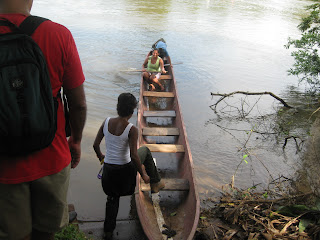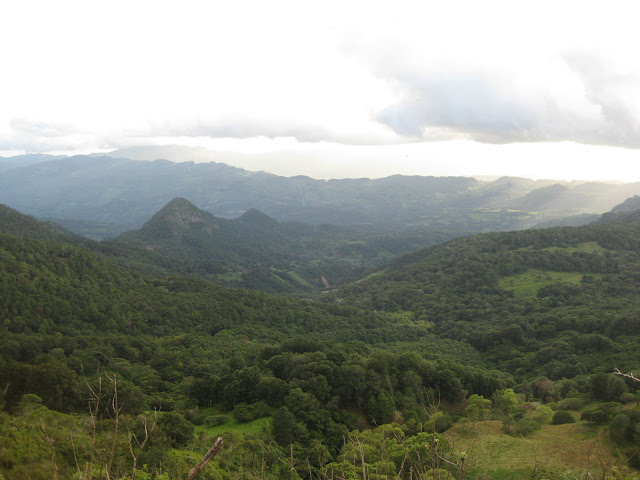 |
| El Castillo with the Spanish fort above. |
We finally arrived in El Castillo and went to our hotel which had an amazing view of the whole town (which was tiny, like it had one street tiny) and the river. Castillo means castle in English if you didn't know. The town is called that after the 17th century Spanish fort built up on the hill overlooking the river. The fort was built to protect the cities on the lake from the actual Pirates of the Caribbean during their hay-day after the city of Granada was sacked something like five times over a span of three years. For me it was really fascinating looking out from the walls of the fort thinking that Henry Morgan (yes the rum guy) rowed up this river with his mates in canoes to go blunder some towns. On Friday, we went to check out a cacao farm. As usual, the adventure to get there was equally as cool as the destination. After hiking through the cows and the mud, we ended up on the shore of the river. On the other side of the river was a house that had a canoe type boat. Our guide whistled and out of the house and into the boat came a mom and her son, who paddled out to our side to ferry us across the river. There were eight of us in the group, and they claimed that we could all fit without sinking the boat and turning us into crocodile and shark (yes the only fresh water sharks in the world live here) food, but this was debatable. We all piled into the canoe anyways which put us about three inches above water level, and remained as still as we could as to not rock in either direction during the crossing. Somehow we made it to the other side, where the dad of the family offered us some coconuts, prodded them out of their tree, and hacked them apart with his machete. Delicious.
 |
| Our lovely "ferry". |
The river crossing process had to be done two more times, one by sketchy canoe, and the other (my favorite) was a contraption that the cacao farm guy had built that was a zipline swing where you would sit on this board and fly across the river to the other side. We had arrived to the cacao farm, where we got to cut open some cacao pods and eat the seeds. The guy who worked at the farm showed us around and pointed out some of the wildlife living there like bats, iguanas, and even a sloth. After the farm, we went to a place where they use the cacao seeds to make actual chocolate. The women who worked there showed us the process of how to make it and we got to help. We then tried the best hot chocolate I have ever tasted and also made our own chocolate candy to take with us. After a long day of hiking and chocolate indulgence, we returned to El Castillo to prepare for another fun day on Saturday. On Saturday, we made the drip down the Rio San Juan to a nature reserve called Indio-Maiz. The entrance of the reserve was also a military outpost since we were in the part of the border where Costa Rica is on one side of the river and Nica on the other (and they don't like each other very much). After some passport information from the very young looking soldiers strapped with AK-47's on their backs, we were off again, shin-deep in mud in the jungle. We got to check out some gigantic trees, tiny poison frogs, and some curious monkeys passing by above us. We even saw jaguar paw prints, which our guide told us were no more than a day old! After a long, muddy hike that had changed my definition of both hot and humid, we ended up by a smaller river surrounded by massive trees and the sounds of howler monkeys, where we got to swim for a little.
We returned to El Castillo and got to relax for the rest of the day. The town is very peaceful and has no cars. The only road is more like an oversized sidewalk where everyone hangs out in their rocking chairs and windows and talks to neighbors. We were on our own for dinner, so the five of us and Morena went to a restaurant and had some Flor (Nicaraguan rum) and played a drinking game called King's Cup. I don't want to boast, but I'm pretty sure we were the very first people to ever play King's Cup in this sleepy fishing town. This of course was made much more difficult as it all was done in Spanish. We awoke the next morning at 4:30 to catch the 5am boat ride back to San Carlos and the airport. The morning boat ride on the river was amazing. We picked up many morning commuters, farmers with mud boots and machetes, and saw hundreds of birds hovering above the river going to town on some bugs. The trip was definitely very cool and very tiring. I will be returning to the Rio San Juan in the future.







